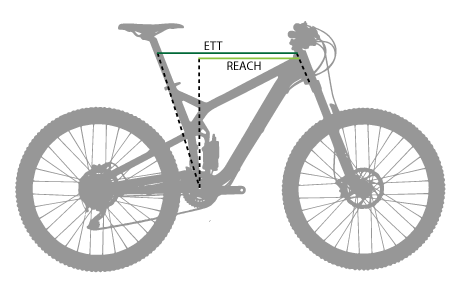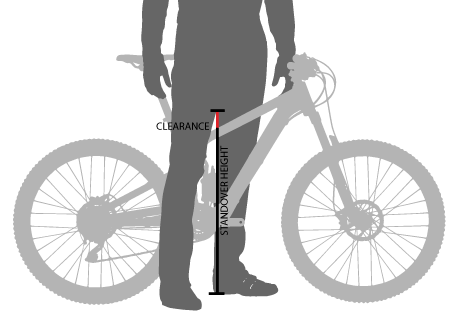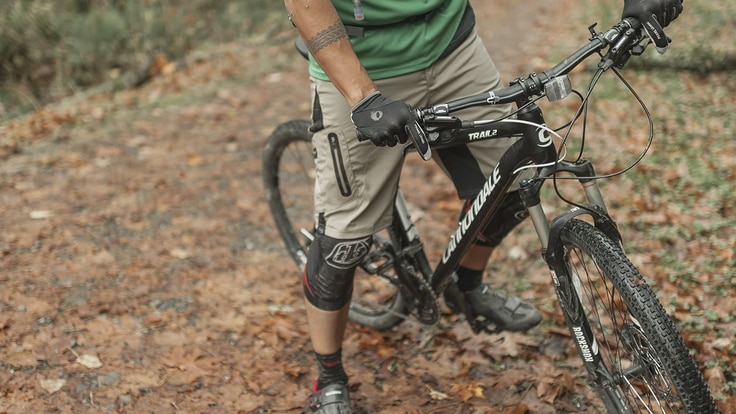A bike that fits well and is right for your height, flexibility and riding style is a bike you'll love riding. A properly fitting bike can improve your handling and confidence on the trail to help you tackle more technical and challenging rides.
Bike sizing can become quite intricate if you are a serious rider looking for specific performance characteristics. This article focuses on entry-level fit considerations. First, some general bike shopping tips:
- Your bike should fit how you currently ride. As you work on building your skills, you can adjust your fit later.
- Get the right frame size. If you don't have the right frame from the outset, you'll have difficulty getting it comfortable no matter what adjustments you make later.
- Fine-tuning the fit: Once you have the right size, you can fine-tune the fit with simple adjustments to the bike's existing components, such as seat height and seat angle. You can also swap out components.
- Hands-on help: A skilled bike tech or sales associate can help you choose the right size bike and/or personalize the fit. We recommend you head to your local REI or bike store to test-ride multiple bikes so you get immediate feedback about what feels best for you.
How Mountain Bikes are Sized
Mountain bikes come in standard sizes (S, M, L) that generally correspond to your height. Many bike manufacturers include size charts that list a height range for each bike size. (If you're in-between sizes, it's best to err on the smaller side as more sizing accommodations can be made with a smaller frame than with one that's too large.)
Having a basic understanding of bike geometry can also be helpful when comparing one bike to another or dealing with a specific fit issue. A few of the key indicators are:
- Effective top tube length
- Reach
- Standover height
- Seat height
Mountain Bike Effective Top Tube and Reach
Effective top tube (ETT) describes the horizontal distance between the head tube and the seat tube, regardless of whether you have a straight top tube or one that slopes down. ETT is a common measurement to look at when sizing a bike and is a good indicator of how long a bike will feel while you're seated.
Reach is the distance from the center of the bottom bracket to the center of the head tube in a horizontal line. Reach has become a more popular way to measure length on mountain bikes because it identifies how long a bike will feel while you're out of the saddle, a common position to be in when descending or climbing steep singletrack.

Mountain Bike Standover Height
Though it's not used as frequently as it once was to size bikes, standover height can still be an indicator of whether or not a bike fits you.
First, make sure you can straddle your bike with your feet flat on the floor. When you lift a mountain bike, you want 2" minimum clearance between the tires and the ground. This allows you to be comfortable getting off the saddle for quick dismounts on the trail. It is not unusual for aggressive riders to seek out 3" to 5" of clearance. Be sure to wear your cycling shoes when evaluating standover height, since they may affect your overall leg length.
Keep in mind that the amount of clearance is largely affected by the slope of the top tube down toward the rear wheel. For example, if the slope is dramatic, you'll likely have ample clearance no matter what size the frame is. Because of this, you can't rely solely on standover clearance to determine if a bike fits.

Online Shopping Tips: REI and most bike brand websites include sizing charts for bikes featured online. Look for listed standover heights, and compare that number to your inseam. The difference between your inseam and the standover height should fall within the target ranges. (For example, if you have a 30" inseam, you'll want a mountain bike with about a 28" standover height.)
To measure your inseam: Gather a large hardcover book or notebook, tape measure and pencil. Then:
- Stand against a wall (with bike shoes on).
- Straddle the book, spine up, as if you were sitting on a saddle.
- Use the pencil to mark where the spine of the book meets the wall.
- Measure from the mark to the floor. This is your inseam.
- Repeat the measurement another time or two to make sure it's accurate.
Mountain Bike Seat Height
When determining if a bike fits you properly it's important to have the seat height correctly adjusted so you can get an accurate feel for the bike. To check your seat position, ask a sales associate or friend to hold the bike upright while you hop on the saddle:
Proper position for climbing hills and riding flat terrain: With your foot at the bottom of the pedal stroke, you should see a slight bend in the leg, reaching about 80-90 percent of full leg extension. This helps you pedal efficiently and powerfully using your major leg muscles.
Proper position for descents: Lowering your seat lowers your center of gravity, which gives you better control and more confidence through steep descents. You'll need to experiment with different seat heights to find what feels best, but start by lowering your seat about 3 in. from the height you set it at for climbing hills and riding flat terrain.
Adjusting the seat height: Loosen the quick-release lever on the seatpost (or use a wrench if there's a binder bolt) and raise or lower the post as needed. Be careful not to raise the post beyond the "minimum insertion mark" etched into its side. (If you need to change the seat height that dramatically, you may need a different frame size.)
Retighten the quick-release lever or binder bolt before riding. (Be careful not to overtighten the binder bolt. Use a torque wrench to tighten the bolt to the manufacturer's specification, or have a mechanic tighten this properly. Be especially careful with a carbon-fiber frame and/or seatpost.)
If you expect to progress quickly on your mountain bike, you may want to look for bikes with dropper seatposts or consider adding one. These seatposts let you raise or lower the seat by pushing a button, helping you adjust instantly to changing terrain.
Fitting Women's Mountain Bikes
Women often have proportionately narrower shoulders and longer legs compared to their torsos than men, and women-specific bikes are designed to meet these needs. Women's bikes often have narrower handlebars and shorter or more compact frame dimensions. Some women find that men's bikes fit well and are comfortable, but women-specific bikes may provide a more precise fit for some.
Fitting Kids' Mountain Bikes
If you're buying a bike for a young rider, it's easy to want one they'll "grow into," but it's especially important to buy a bike that fits well so he or she can ride comfortably and confidently while learning.
Standover height: As with adult bikes, check the standover height. Whatever the top-tube style, look for about 2"-4" of clearance.
Seat height: Most kids' bikes are designed so they ride in a more upright position. They should be able to sit comfortably, see around them easily and grip the handlebars with a slight bend in their elbows. Their legs should be slightly bent at the bottom of the pedal stroke.
